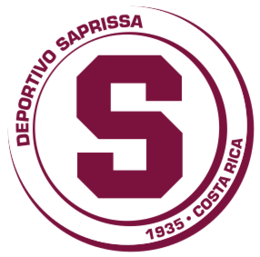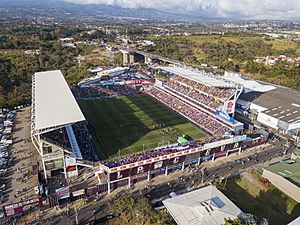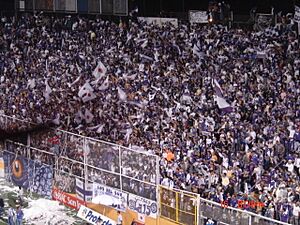Deportivo Saprissa facts for kids
 |
|||
| Full name | Deportivo Saprissa, SAD | ||
|---|---|---|---|
| Nickname(s) | Los Morados (The Maroon Ones) El Monstruo (The Monster) La S (The S) El Glorioso (The Glorious) El Sapri (The Sapri) Rey de Copas (King of Cups) |
||
| Founded | 16 July 1935; 90 years | ||
| Ground | Estadio Ricardo Saprissa Aymá | ||
| Capacity | 23,112 | ||
| Owner | Horizonte Morado | ||
| Chairman | Juan Carlos Rojas Callán | ||
| Manager | Ángel Luis Catalina | ||
| Coach | Paulo Wanchope | ||
| League | Liga Promerica | ||
| Apertura 2024 | 1st (champions) | ||
|
|
|||
Deportivo Saprissa is a famous sports club from Costa Rica. It is best known for its amazing football team. The club is located in San Juan de Tibás, San José. They play their home games at the Estadio Ricardo Saprissa Aymá. Their team colors are burgundy and white.
Saprissa is the main team for the capital city, but fans follow them all over Costa Rica and even in other countries. The club started in 1935. They have played in Costa Rica's top football league since 1949. The team is named after one of its main founders, Ricardo Saprissa Aymá.
One of their most popular nicknames is El Monstruo Morado, which means The Maroon Monster. This nickname started in 1987. A Costa Rican newspaper, Diario Extra, gave them this name during a big game. A reporter saw the huge crowd of fans wearing purple at the stadium. The noise they made was so loud, it felt like being "in the presence of a thousand headed monster". Saprissa quickly adopted the nickname. It is still the most celebrated football team in the entire region.
Saprissa has won 40 Primera División de Costa Rica championships. This includes winning six national titles in a row during the 1970s! They are also one of the most successful teams in the CONCACAF region. They have won the CONCACAF Champions' Cup three times: in 1993, 1995, and 2005. Saprissa has also won five Central American championships.
From September 2007 to August 2008, Saprissa was ranked the 106th best team in the world. This ranking came from the International Federation of Football History & Statistics, an organization recognized by FIFA. Saprissa has often reached the finals of the CONCACAF Champions Cup. They have won three times and been runners-up four times.
A very special moment for the club was in 2005. Saprissa became only the second club from CONCACAF to finish third in the FIFA Club World Cup. The Mexican club Necaxa did it in 2000. Later, C.F. Monterrey (2012) and C.F Pachuca (2017) also achieved this.
The IFFHS chose Saprissa as the CONCACAF team of the 20th Century. This award brought Saprissa worldwide attention. Their main partner is a Costa Rican investment group called Horizonte Morado. It includes Juan Carlos Rojas Callán, Edgar Zurcher, and Televisora de Costa Rica.
Contents
Club History and Achievements
How Saprissa Started
Deportivo Saprissa was founded on July 16, 1935. A person named Roberto Fernández started the team. He named it after Don Ricardo Saprissa Aymá, who helped pay for their uniforms. The club first joined the Costa Rican Third Division as Saprissa F.C..
They moved up to the Primera División de Costa Rica, the top league, and played their first game there on August 21, 1949. In their early years, they won the third and second division titles without losing a single game! The club has stayed in Costa Rica's top league ever since.
Big Wins and Important Moments
In 2003, a Mexican businessman named Jorge Vergara bought most of the club's shares. He also owned the Mexican football club Club Deportivo Guadalajara.
Saprissa won the 2005 CONCACAF Champions Cup. They beat the Mexican club UNAM in the final in May 2005. Because they were the CONCACAF champions, they got to play in the 2005 FIFA Club World Championship in Japan in December 2005.
They beat the Australian club Sydney FC in the quarter-finals. Christian Bolaños scored the winning goal. In the semi-finals, they lost 3-0 to the English club Liverpool. Liverpool was the strongest team in Europe that year. In the match for third place, Saprissa beat Al Ittihad from Saudi Arabia 3-2. Álvaro Saborío scored two goals. Rónald Gómez scored an amazing free-kick goal in the 89th minute to win the game! After this "late goal," Costa Ricans started calling late-game goals "La Saprihora" (The Sapritime). This is still used today for Saprissa goals scored after the 85th minute.
Saprissa finished third in the competition. São Paulo from Brazil was first, and Liverpool was second. Saborío was one of the top goal scorers. Bolaños received the Bronze Ball from FIFA as the third-best player in the championship.
Team Colors and Uniforms
Even though Saprissa's first colors were red and white, the team is famous for its purple-burgundy color. Red and white were used for a very short time. Ricardo Saprissa was inspired by the Polo Club of Barcelona and tried red and blue.
When the new uniforms for 1937 were being made (red and blue), some threads got mixed. This created a type of purple, like a burgundy or maroon color. Everyone liked this new color! It looked classy and unique. So, it became the team's official color. They decided the team's shield would be on the chest of the uniform, with a clear, bold white letter "S".
Today, Saprissa wears a purple/burgundy jersey with white and grey details for home games. They also wear white shorts with burgundy and grey details. For away games, they use a white jersey with burgundy and grey details, and white shorts with burgundy and grey details.
Home Stadium: The Monster's Cave
Saprissa plays its home games at the Estadio Ricardo Saprissa Aymá. It is named after Ricardo Saprissa. The team used to rent and share the Costa Rica National Stadium.
A new place for a stadium was bought in 1965. After six years of building and improvements, the Estadio Ricardo Saprissa officially opened on August 27, 1972. The first game was between Deportivo Saprissa and Comunicaciones from Guatemala. The game ended in a 1-1 tie. Peter Sandoval of Comunicaciones scored the first goal in the new stadium.
The stadium is also called La Cueva del Monstruo (The Monster's Cave/Lair) or simply La Cueva (The Lair). This nickname comes from the club's own nickname, El Monstruo Morado ("The Purple Monster"). It can hold 24,000 people. The stadium is surrounded by local mountains and the city of San Jose. It is well-known internationally, especially by national teams that play against Costa Rica there.
Passionate Supporters
La Ultra Morada (The Purple Ultra) is the club's most dedicated group of supporters. This group always sits on the south side of the stadium. They are known for creating a very exciting atmosphere during matches.
This group was the first "Ultras" group in Costa Rica. It started in 1995. The president of Saprissa at the time, Enrique Artiñano, brought fans from a Chilean football club to help create a similar group for Saprissa. The Ultras are famous for their chants, choreographed displays, flares, flags, giant banners, and the constant beat of a huge drum.
There are also other supporter groups that are officially recognized by the club. These groups sit in different parts of the stadium. They often organize transportation, special merchandise, and big displays for the team during games. This includes confetti, balloons, and banners.
Team Mascot
The official mascot of the team is a friendly, cartoonish purple dragon. It was inspired by dragons from popular children's shows. Because of this, many fans call the mascot Un monstruo amigable, which means "a friendly monster". The mascot was made to appeal to children, but all the fans ended up loving it. It appears on all kinds of team items and is the most recognized mascot in the region.
In the early 2010s, a new mascot was introduced. It was designed in Mexico and looked like a superhero-like purple monster. Many fans did not like it. They said, "No queremos un dinosaurio super héroe, queremos al espíritu del equipo" (We don't want a super hero dinosaur, we want the original spirit of the team).
Because of this strong reaction, the new mascot was quickly replaced. The team now has a new mascot that looks like the original one. A famous puppeteer from Argentina, Fernando Thiel, who lives in Costa Rica, made the new costume.
Big Rivalries: El Clásico
When Deportivo Saprissa plays against Alajuelense, it is called El Clásico (The Classic). Saprissa is from Tibás, in San José. Alajuelense is from Alajuela.
The first game between these two teams was on October 12, 1949. Alajuelense won that game 6-5. As of today, Saprissa has won 139 matches, Alajuelense has won 107, and they have tied 109 times.
Team Honours and Awards
National Titles
- Primera División de Costa Rica (Top League)
- Champions (40 times): 1952, 1953, 1957, 1962, 1964, 1965, 1967, 1968, 1969, 1972, 1973, 1974, 1975, 1976, 1977, 1982, 1988, 1989, 1993–94, 1994–95, 1997–98, 1998–99, 2003–04, 2005–06, 2006–07, Invierno 2007, Verano 2008, Invierno 2008, 2010 Verano, 2014 Verano, 2014 Invierno, 2015 Invierno, 2016 Invierno, Clausura 2018, Clausura 2020, Clausura 2021, Apertura 2022, Clausura 2023, Apertura 2023, Clausura 2024
- Torneo de Copa de Costa Rica (Costa Rican Cup)
- Champions (6 times): 1950, 1960, 1963, 1970, 1972, 2013
- Supercopa de Costa Rica (Supercup)
- Champions (3 times): 1976, 2021, 2023
- Recopa de Costa Rica (Recopa Cup)
- Champions (2 times): 1963, 2023
- Segunda División de Costa Rica (Second Division)
- Champions (1 time): 1948
- Tercera División de Costa Rica (Third Division)
- Champions (1 time): 1947
International Titles
Worldwide Competitions
- FIFA Club World Cup
- Third place (1 time): 2005
Continental Competitions
- CONCACAF Champions Cup
- Champions (3 times): 1993, 1995, 2005
- CONCACAF League
- Champions (1 time): 2019
Regional Competitions
- Copa Fraternidad/Torneo Grandes de Centroamérica/Copa Interclubes UNCAF (Central American Club Cup)
- Champions (5 times): 1972, 1973, 1978, 1998, 2003
Friendly Competitions
- Torneo Relámpago de Fútbol de Costa Rica: 1949, 1957
- Copa Mayid Barzuna: 1954
- Trofeo Vuelta al Mundo: 1959
- Copa Ricardo Saprissa: 1982, 1989
- Copa Camel: 1985
- Copa 90 Minutos por la Vida: 1999, 2004, 2007, 2009, 2011
Awards
- CONCACAF League Fair Play
- Winners (1 time): 2019
Current Team Players
As of January 30, 2025
|
|
Players on Loan to Other Teams
|
|
See also
 In Spanish: Deportivo Saprissa para niños
In Spanish: Deportivo Saprissa para niños
- CONCACAF Champions Cup and Champions League records and statistics
- List of Deportivo Saprissa players




